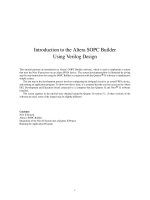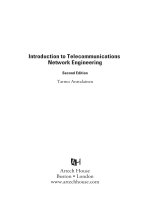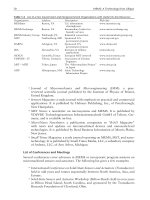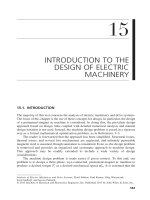Diesel Introduction to the Diesel Engine
Bạn đang xem bản rút gọn của tài liệu. Xem và tải ngay bản đầy đủ của tài liệu tại đây (1.38 MB, 42 trang )
Introduction to the Diesel Engine
A Curriculum for Agricultural Producers
Prepared by
For the
National Center for Appropriate Technology
With funding and cooperation from the
USDA Risk Management Agency
Outline
• Engine operations
• Engine Components
• Fuel Properties
Diesel Vocabulary
•
•
•
•
•
•
•
•
•
•
•
•
•
•
•
•
Aftercooling/Intercooling
Turbocharging
Cetane Number
Cloud Point (CP)
Flash Point
Cold Filter Plugging Point (CFPP)
Pour Point
Compression Ignition (CI)
Direct Injection (DI)
In-Direct Injection (IDI)
In-Line Injection Pump
Nitrogen Oxides (NOx)
Pump-Line-Nozzle Fuel System
Rotary Injection Pump
Unit Injector
Common Rail Injection
What is a Diesel Engine?
•
•
•
•
Rudolf Diesel developed the
idea for the diesel engine and
obtained the German patent for
it in 1892.
His goal was to create an
engine with high efficiency.
Gasoline engines had been
invented in 1876 and,
especially at that time, were not
very efficient
Both the gasoline and diesel
engine utilize the process of
internal combustion for power
The diesel engine: first patented in 1892
The Diesel engine was initially Intended to run on coal dust.
Rudolph Diesel (1858 – 1913)
Diesel demonstrated his engine at the Exhibition Fair in Paris, France in 1898.
This engine was fueled by peanut oil - the
"original" biodiesel.
The first Diesel race car placed 13th in the Indianapolis 500
because it never stopped to refuel…
In 1973 and 1978, OPEC reduced the supply of oil and raised the price….
The American public looked to diesel fuel which was more efficient and economical and they
began buying diesel-powered automobiles.
This surge of diesel sales in American ended in the 1980's.
What is Internal Combustion?
Four stroke cycle
• Intake stroke: intake valve opens while the piston moves
down from its highest position in the cylinder to its lowest
position, drawing air into the cylinder in the process.
• Compression stroke: intake valve closes and the piston
moves back up the cylinder.
This compresses the air & therefore heats it to a high
temperature, typically in excess of 1000°F (540°C).
Near the end of the compression stroke, fuel is injected into
the cylinder. After a short delay, the fuel ignites spontaneously,
a process called auto ignition.
• Combustion stroke: The hot gases produced by the
combustion of the fuel further increase the pressure in the
cylinder, forcing the piston down
• Exhaust stroke: exhaust valve opens when the piston is
again near its lowest position, so that as the piston once
more moves to its highest position, most of the burned
gases are forced out of the cylinder.
Four stroke Cycle
Gasoline versus Diesel
• Spark ignition:
• Gasoline engines use spark plugs to ignite fuel/ air mixture
• Compression ignition:
• Diesel engines uses the heat of compressed air to ignite the fuel
(intakes air, compresses it, then injects fuel)
• Fuel injection:
• Gasoline uses port fuel injection or carburetion;
• Diesel uses direct fuel injection or pre combustion chambers (indirect
injection)
• Glow plugs:
• electrically heated wire that helps heat pre combustion chambers fuel
when the engine is cold
• when a diesel engine is cold, compression may not raise air to
temperature needed for fuel ignition
Compression Ratio
• Compression ratio:
• This is defined as the ratio of the volume of the cylinder at the
beginning of the compression stroke (when the piston is at BDC) to the
volume of the cylinder at the end of the compression stroke (when the
piston is at TDC).
• The higher the compression ratio, the higher the air temperature in the
cylinder at the end of the compression stroke.
• Higher compression ratios, to a point, lead to higher thermal
efficiencies and better fuel economies.
Diesel engines need high compression ratios to generate the high
temperatures required for fuel auto ignition.
• In contrast, gasoline engines use lower compression ratios in order to
avoid fuel auto ignition, which manifests itself as engine knock or
pinging sound
• Common spark ignition compression ratio: 8:1 to 12:1
• Common compression ignition ration: 14:1 to 25:1
•
Direct Injection vs. Indirect
Injection
Diesel Ignition System
•
•
Glow plug
Glow plug relay
•
•
•
Fusible Link
Glow Plug Temp Sensor
Heat Sink
Diesel Fuel System
•
•
Fuel filter
Fuel pumps : Injection pump
and/ or Lift/Transfer pump
•
Fuel Injectors
The fuel injection systems on the John Deere PowerTech Plus engines
operate at 29,000 psi
Photos compliments of the National Alternative Fuel Training Consortium
Injection Pumps
•
•
A rotary type fuel injection
pump is "round" in shape with
the fuel fittings arranged
around the pump.
An in-line type fuel injection
pump is more "rectangular" or
square in shape with the fuel
fittings arranged in a straight
line.
In-Line Injection Pumps
• An injection pump with a
separate cylinder and plunger
for each engine cylinder.
• Each plunger is rotated by a
rack to determine metering via
ports in the body of the pump
and helical cuts on the pump
plungers.
• The plungers are driven off a
camshaft, which usually
incorporates a centrifugal or
electronically controlled timing
advance mechanism.
Rotary Injection Pump
A lower-cost injection pump used with pumpline-nozzle systems.
The pump has a central plunger system
(usually consisting of two opposing plungers)
that provides fuel to every cylinder during the
required injection period.
A plate located near the top of the pump
rotates, opening an appropriate orifice at the
right time for distribution to each cylinder’s
injection nozzle through a separate line.
It is usually used with automotive or agricultural
engines that have lower performance and
durability requirements than the heavy-duty
truck engines.
Pump-Line-Nozzle Fuel
System
A fuel system using a single injection pump driven off the
geartrain on the front of the engine that also drives the
camshaft.
The central injection pump feeds a separate injection nozzle
located in the cylinder head above each cylinder.
Lines which must be of exactly equal length link each pump
plunger with the associated nozzle.
Each nozzle incorporates a needle valve and the orifices which
actually handle atomization.
Common Rail Injection
A diesel fuel injection system employing a common pressure accumulator, called the rail, which is
mounted along the engine block.
The rail is fed by a high pressure fuel pump.
The injectors, which are fed from the common rail, are activated by solenoid valves.
The solenoid valves and the fuel pump are electronically controlled.
In the common rail injection system the injection pressure is independent from engine speed and
load.
Therefore, the injection parameters can be freely controlled.
Usually a pilot injection is introduced, which allows for reductions in engine noise and NOx
emissions.
This system operates at 27,500 psi (1900 BAR). The injectors use a needle-and-seat-type valve
to control fuel flow, and fuel pressure is fed to both the top and bottom of the needle valve. By
bleeding some of the pressure off the top, the pressure on the bottom will push the needle off its
seat and fuel will flow through the nozzle holes.
Common Rail Fuel
Injection Schematic
Common Rail Injection Vehicles
Turbochargers &
Superchargers
•
•
•
•
•
•
Increase or compress more air to be
delivered to each engine cylinder
Superchargers: mechanically driven from
engine crankshaft
Turbochargers: driven by waste exhaust
gases
Increased air mass improves the
engine's thermal efficiency (fuel
economy) and emissions performance,
depending on other factors.
Turbochargers must operate at high
temperatures and high rotational speeds.
Variable Geometry Turbochargers









